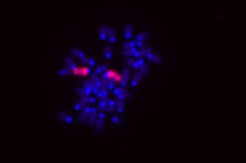Early sex differences
X-chromosomal influence makes female embryos grow more slowly
A Berlin research team has found genes on the X chromosome that explain the differences between male and female embryonic development. The findings may be relevant for gender sensitive medicine and stem cell therapy.

The “small difference” between the sexes is tiny in the early embryo and cannot be seen with the naked eye, when the fertilized egg has just divided a few times and turned into a ball of stem cells. And yet the course is already being set for differences between the biological sexes.
In mice, for example, early development of the female embryo is delayed compared to male embryos. "Why female mammals develop more slowly is unclear and the subject of discussions and conjecture," says Edda G. Schulz, research group leader at the Max Planck Institute for Molecular Genetics (MPIMG) in Berlin. “But it is obvious that genes on the X chromosome and their dosage are responsible for the delay in development – and we wanted to find out, which genes exactly. ”
What makes the cells wait
Together with her team, Schulz set out to find the factors that cause this developmental delay in female cells . “We systematically screened the genes on the X chromosome,” says Oriana Genolet, doctoral student in Schulz's team and first author of the study, which recently appeared in the journal Genome Biology. They found the genes named Dusp9 and Klhl13, which encode proteins that regulate the MAPK signalling pathway. Via this cellular communication channel, a cell decides whether it will continue to grow and specialise – or remain in its stem cell state.
For their study, the researchers used the CRISPR-Cas9 system, which allows very precise editing of the genome. “We initially deactivated almost a thousand genes on the X chromosome in a stem cell culture system, but only one gene was allowed to mutate in each cell,” says Genolet. “Subsequently, we were able to enrich the cells with an altered MAPK signaling pathway and find out, which particular gene was mutated in these cells.” Dusp9 and Klhl13 had the greatest influence on the stem cell properties in this experiment.
The dose makes the effect
The fact that the genes for the two proteins are on the X chromosome makes them particularly interesting. Cells of male mammals usually have one X and one Y chromosome, whereas female cells have two X chromosomes – but they really only need one. Some time after fertilisation, the cells of a female embryo therefore switch off one surplus X chromosome, explains Schulz. “During the first days of development, female cells get sort of a double dose of X chromosomal genes, which is why this stage is so exciting for research of gene-dosage effects.”
Indeed, the scientists were able to shorten the developmental delay by deactivating the two newly found genes on one of the two female X chromosomes. "With a single dose of the proteins, female embryonic stem cells are more like their male counterparts, that is, almost as if there was no second X chromosome at all," says Schulz. Conversely, male cells turned out more “female-like” if they were given a double portion of these proteins.
Consequences for sexual differentiation, gender medicine and stem cell therapy
“We didn't just find central regulators for early sexual differentiation in mouse embryonic stem cells,” says Genolet. “We were also able to show how an additional chromosome can influence the cell state globally. We see similar dosage effects of chromosomes in trisomies, for example.“
The findings on mouse stem cells might also help to draw conclusions for diseases in humans, as Schulz explains. "Men and women are predisposed to certain types of cancer differently, and this does not necessarily have to be due to the influence of hormones," says the group leader. “Components of the MAPK signalling pathway are often mutated in cancer and no longer function correctly. It is possible that sex-specific dosage effects play a role here, as the inactive X chromosome in women may become activated again in cancer cells.“
The results may also have consequences for stem cell therapy, because the inactivation of the X chromosome gets sometimes lost when cultivating induced human pluripotent stem cells (iPS cells). The consequences are unclear. After all, the X chromosome is among the more important chromosomes with five percent of known human genes being located here. They are responsible for reproduction, brain development and cognitive processes such as perception and learning – and they must be dosed precisely.












